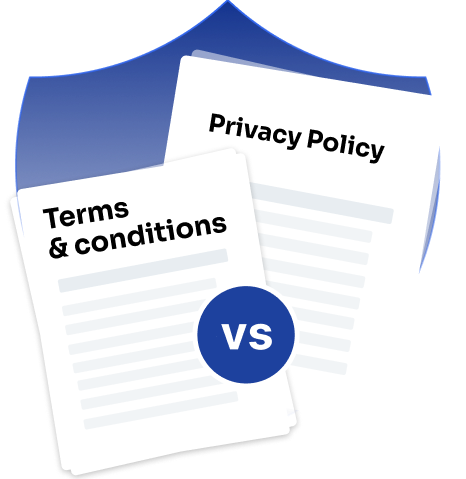Introduction
In the realm of online business, it is crucial to distinguish between privacy policies and terms and conditions. These two legal documents serve different purposes and are essential for protecting the business owner and the users. This article explores the key differences between these documents, their importance, and how they help comply with various data protection laws, such as the General Data Protection Regulation (GDPR) and the California Consumer Privacy Act (CCPA).
Privacy policies and terms and conditions are critical legal documents for online businesses. A privacy policy focuses on how a business collects, uses, and protects personal data, ensuring compliance with data protection laws like GDPR and CCPA. It informs users about their data rights and the business’s data practices, including data collection, processing, and protection measures. Terms and conditions, on the other hand, outline the rules and guidelines for using the website or service. They cover aspects such as acceptable use, intellectual property rights, limitations of liability, and dispute resolution. These documents help limit legal risks and set clear expectations for users. Both documents are legally required for most online businesses and must be regularly updated to reflect changes in laws and business practices.
Defining legal agreements
Legal agreements play a crucial role in defining the rights and obligations of all parties involved in a transaction or a relationship. In the realm of online businesses, two fundamental types of legal agreements are privacy policies and terms and conditions. Privacy policies detail how user information is collected, stored, and used, while terms and conditions outline the rules and guidelines for using a website or service. These documents serve to establish clear expectations and provide a framework for addressing any disputes or disagreements that may arise between the website owner and its users.
Understanding privacy policies
Privacy policies are crucial legal documents that inform users about the collection, usage, and protection of their personal data. These policies play a vital role in ensuring compliance with data protection laws and fostering user trust. A comprehensive privacy policy typically contains detailed information about the types of personal data being collected, including but not limited to IP addresses and personally identifiable information. It also outlines the specific purposes for which data is being collected and the measures implemented to safeguard user data from unauthorized access or misuse.
Purpose of terms and conditions
Terms and conditions, also referred to as terms of service or terms of use, are essential legal agreements that establish the rules and guidelines for using a website or mobile app. These documents serve as the contract between the website owner or app developer and the user. They cover a wide range of topics including acceptable use of the platform, account termination policies, intellectual property rights, dispute resolution procedures, privacy policies, data protection, and any disclaimers or warranties. Essentially, terms and conditions are crucial for setting out the rights and responsibilities of both the platform owner and the users, helping limit legal liability for the website owner, and providing a clear framework for user conduct.
Legal requirements and compliance
In order to ensure legal compliance, most online businesses are required to have both privacy policies and terms and conditions in place. This is especially important to comply with relevant laws such as the General Data Protection Regulation (GDPR), California Consumer Privacy Act (CCPA), and other international data protection laws. These documents must be regularly updated to reflect any changes in the law and business practices to ensure ongoing compliance and protection of user data, as non-compliance may result in legal penalties.

Key differences
The main difference between privacy policies and terms and conditions lies in their focus and content. A privacy policy is primarily concerned with protecting users’ personal data, whereas terms and conditions govern the overall use of the website or service. Privacy policies address data collection, processing, and protection, while terms and conditions cover usage rules, intellectual property, and legal liabilities. Here are the key differences:
Purpose:
Privacy policy: A privacy policy informs users about how the business collects, uses, and protects their personal data. It addresses data privacy concerns and ensures compliance with data protection laws such as the General Data Protection Regulation (GDPR) and the California Consumer Privacy Act (CCPA).
Terms and conditions: This document sets the rules and guidelines for using the website or service. It covers the rights and responsibilities of both the users and the business and helps protect the business from legal liabilities by setting out the terms of use.
Content:
Privacy policy: Includes details about the types of personal data collected, how data is used, who it is shared with, and the measures taken to protect data. It also explains users’ rights regarding their personal data.
Terms and conditions: Covers aspects such as acceptable use, user obligations, intellectual property rights, disclaimers, limitations of liability, and dispute resolution procedures. It defines how users can interact with the site or service.
Legal focus:
Privacy policy: Focuses on compliance with privacy laws and regulations, ensuring that the business meets legal requirements for data protection.
Terms and conditions: Focuses on protecting the business from legal risks and liabilities by setting clear rules and expectations for users.
Protection:
Privacy policy: Primarily protects users by informing them about their data rights and how their data is handled.
Terms and conditions: Protects the business by limiting liability and providing a clear framework for acceptable use and dispute resolution.
User interaction:
Privacy policy: Describes how the business interacts with user data.
Terms and conditions: Specifies how users should interact with the business’s website or service.
By understanding these key differences, businesses can ensure they provide both documents to protect their interests and comply with legal obligations.
Data collection practices
In order to comply with regulations and build trust with users, it is necessary for privacy policies to provide detailed information about the specific data collection practices of the business. This comprehensive information for data subjects should include a clear and thorough outline of the types of personal data that are collected, the methods employed for collection, and the explicit purposes for which the data is collected. Furthermore, the privacy policy should encompass detailed information about the use of tracking technologies, cookies, and any sharing of data with third parties. Ensuring transparency in data collection practices is crucial for complying with regulations and fostering trust with users.
User rights and data protection
Numerous laws, including the General Data Protection Regulation (GDPR) and the California Consumer Privacy Act (CCPA), have been established to grant individuals specific rights regarding their personal data. These rights encompass the capacity to access one’s data, rectify any inaccuracies, request the removal of personal information, and restrict the processing of their data.
Privacy policies should comprehensively articulate these rights, not only to ensure adherence to legal requirements but also to empower individuals to exercise greater influence over the handling of their personal information. Organizations can exhibit their dedication to data protection and privacy by furnishing transparent and thorough information about user rights. This fosters trust and transparency while bolstering an individual’s control over their personal data.
Limiting legal liability
The terms and conditions of a website are a vital component that serve to outline the rules and regulations governing the use of the website or service. These documents are crucial as they help to establish the rights and responsibilities of both the website owner and the users. They contain important clauses such as disclaimers of warranties, limitations of liability, and indemnification clauses, which are essential in protecting the website owner from legal disputes and potential liabilities. Furthermore, they help to establish clear guidelines for using the website and outline the legal consequences of any misuse or violation of the terms. Overall, the terms and conditions play a significant role in safeguarding the interests of the website owner and ensuring a fair and safe online environment for all users.

Intellectual property and licensing rights
Terms and conditions often contain provisions related to intellectual property rights, which are crucial for outlining the website owner’s ownership of the content and services they provide. These contractual agreements also touch upon licensing rights, specifying the ways in which users can utilize the content and any limitations on its use. Safeguarding intellectual property is essential for protecting the business’s valuable assets and revenue streams.
Governing law and dispute resolution
It is essential for both privacy policies and terms and conditions to explicitly state the governing law and provide a thorough explanation of legal requirement and the dispute resolution process. By doing so, it ensures that any legal issues that may arise are handled in accordance with the laws of a specific jurisdiction, and it also establishes a clear and defined procedure for addressing conflicts. By incorporating clear and comprehensive dispute resolution mechanisms, potential legal problems can be prevented, and an effective framework for resolving issues efficiently can be established.
User-generated content
Terms and conditions frequently contain specific provisions pertaining to user-generated content, which can encompass comments, reviews, and uploads. These clauses typically delineate the guidelines for sharing content, specify the website owner’s entitlements to utilize the content, and establish any limitations on posting inappropriate or unlawful material. Effectively managing user-generated content is vital for upholding a secure and courteous online community.
International data transfers
Businesses that collect personal data and conduct operations on an international scale must carefully consider their privacy policies to account for the transfer of personal data across borders. This involves ensuring compliance with the stringent privacy laws outlined by the European Union as well as other relevant international regulations. Providing clear and comprehensive guidelines on how international data transfers are managed is crucial for guaranteeing legal compliance and safeguarding user data during cross-border processing.

Shopify and legal documents
As a Shopify store owner, it is essential to have both a privacy policy and terms and conditions in place to ensure legal compliance and build trust with customers. Shopify offers tools and templates to assist in creating these documents, enabling store owners to clearly define their privacy practices and usage rules. By implementing these documents, Shopify store owners can establish transparency, gain customer trust, and reduce legal risks associated with their business operations.
Updating frequency for privacy policies and terms and conditions
Regularly updating privacy policies and terms and conditions is crucial for businesses to ensure compliance with legal requirements and to reflect any changes in business practices. Here is the recommended frequency for updating these documents:
Privacy policies:
Annual review: It is generally recommended to review and update your privacy policy at least once a year. This helps ensure ongoing compliance with evolving data protection laws such as the GDPR and CCPA.
Significant changes: Any significant changes to how personal data is collected, used, or shared should prompt an immediate update. Additionally, updates are necessary when there are changes in applicable laws or regulations.
Terms and conditions:
Annual or biannual review: Similar to privacy policies, terms and conditions should be reviewed and updated at least once a year, or more frequently if there are major changes in the business model, services offered, or legal environment.
Immediate updates: Whenever there are changes to the services, pricing, or other critical aspects of the business, the terms and conditions should be updated immediately to reflect these changes and to limit potential legal liabilities.
Regular updates to both privacy policies and terms and conditions are essential for maintaining legal compliance and protecting both the business and its users.
Conclusion
Understanding the distinctions between privacy policies and terms and conditions is crucial for any online business owner. Privacy policies are essential legal documents that outline how a company collects, uses, and protects user data. On the other hand, terms and conditions govern the use of the website or app and establish the contractual relationship between the business and its users. Both documents are vital for legal compliance, as they help protect user data and limit the business’s liability. It’s important for business owners to ensure that these documents are comprehensive and regularly updated to reflect any changes in the business operations or legal requirements. This way, they can effectively safeguard their operations and establish trust with their users.




